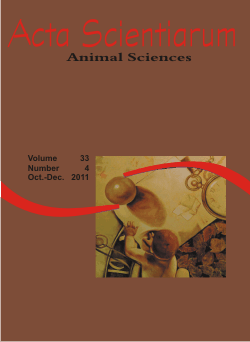<b>Feeding rate in the performance of juveniles of fat-snook <i>Centropomus parallelus</i> in net cage</b> - doi: 10.4025/actascianimsci.v33i4.11413
Keywords:
Centropomus parallelus, feeding, fish culture, growth, intensive rearing
Abstract
Knowing the optimal feeding rate for a given species is important not only to promote higher growth and greater feeding efficiency, but also to prevent the deterioration of water quality resulting from excess food. This study aimed to evaluate the performance of the fat-snook Centropomus parallelus cultivated in net cages under the effect of different feeding rates (1, 1.5, 2 and 2.5% live biomass daily and control rate up to apparent satiation) in natural environment conditions. For 40 days, each treatment was evaluated in triplicate, in which the biological parameters (survival, specific growth rate, final average weight and length) and nutritional parameters (feed conversion ratio) were assessed. A polynomial regression analysis of specific growth rate suggests that in average temperatures of 25°C, the feeding rate which results in best growth for juvenile fat-snook is 1.7% of live biomass per day.Downloads
Download data is not yet available.
Published
2011-04-28
How to Cite
Barbosa, M. C., Neves, F. de F., & Cerqueira, V. R. (2011). <b>Feeding rate in the performance of juveniles of fat-snook <i>Centropomus parallelus</i> in net cage</b> - doi: 10.4025/actascianimsci.v33i4.11413. Acta Scientiarum. Animal Sciences, 33(4), 369-372. https://doi.org/10.4025/actascianimsci.v33i4.11413
Issue
Section
Nonruminant Nutrition
DECLARATION OF ORIGINALITY AND COPYRIGHTS
- I Declare that current article is original and has not been submitted for publication, in part or in whole, to any other national or international journal.
The copyrights belong exclusively to the authors. Published content is licensed under Creative Commons Attribution 4.0 (CC BY 4.0) guidelines, which allows sharing (copy and distribution of the material in any medium or format) and adaptation (remix, transform, and build upon the material) for any purpose, even commercially, under the terms of attribution.
Read this link for further information on how to use CC BY 4.0 properly.
0.9
2019CiteScore
29th percentile
Powered by 








































